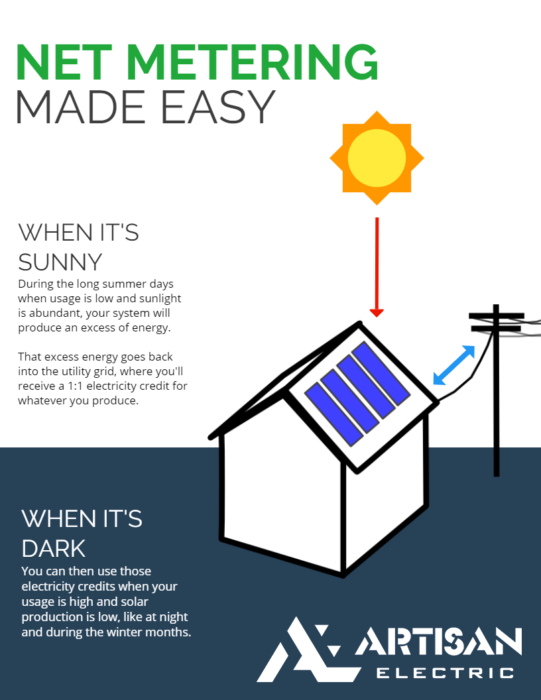Net Metering Is Critical for Washington State’s Energy Future
Last week, the Washington State legislature passed the Solar Fairness Act (SB 6081) out of the State Senate, and the bill is currently making its way through the House of Representatives.
The full House will vote on this bill by the end of this week!
SB 6081 ensures owners of solar systems have the right to use the electricity they make. This bill raises the Net Electricity Metering (NEM) quota for all electric utilities (such as Seattle City Light and Puget Sound Energy) from 0.5% to 2% of their peak electricity demand (set at 1996 rates). Currently, the state’s total net-metered renewable energy accounts for less than 0.5% of electricity generated in the state. But as more solar is installed, renewable energy will account for more of Washington’s electrical generation. This bill protects our ability to use net metering to store our excess electricity until we need it later. NEM is primarily used for solar photovoltaic (PV) systems, though other distributed generation (DG) customers such as wind, water and biogas share the 2% quota.
What is Net Metering?
With net metering, your electric utilit y becomes your energy bank. A bi-directional meter replaces your existing electricity meter to track the production and use of your home’s energy. When your solar energy system produces more power than you are using, the excess electricity spins this meter backwards, giving you a dollar-for-dollar utility credit for all the excess energy. At night, when the sun is not shining, you make withdrawals from the grid and use the credits you stored earlier in the day. In the summer, when days are long and sunny, most customers produce more energy than they need, building up credits with their utility that are used to offset their usage in the wintertime, when days are short and cloudy.
y becomes your energy bank. A bi-directional meter replaces your existing electricity meter to track the production and use of your home’s energy. When your solar energy system produces more power than you are using, the excess electricity spins this meter backwards, giving you a dollar-for-dollar utility credit for all the excess energy. At night, when the sun is not shining, you make withdrawals from the grid and use the credits you stored earlier in the day. In the summer, when days are long and sunny, most customers produce more energy than they need, building up credits with their utility that are used to offset their usage in the wintertime, when days are short and cloudy.
Why is Net Metering so important for Washington State?
Washington State has a growing population and growing electricity demand. Investing in new electrical power plants to meet growing demand is expensive and resource-intensive for utilities. Moreover, consumer usage patterns are shifting. Unlike most of the country, Washington’s peak loads are in the winter. As our climate warms, however, more people are using air conditioners in the summer, shifting the seasonal loads. Transportation has historically accounted for very little electricity usage. With the explosion of electric vehicles on the road, electricity demand is increasing in the evening as people plug in to charge their vehicles. To meet these new demands, utilities are turning away from fossil fuel and promoting energy efficiency and renewables. Puget Sound Energy’s 2016 Electricity Fuel Mix, for instance, is 37% coal and 22% gas. PSE plans to retire some of its coal plants, and replace that power with energy efficiency, renewables, and more gas. Solar power is playing a key role in helping the state meet future energy demands from shifting and increasing peak loads.
Solar is not just another centralized utility fuel source like nuclear, coal or natural gas. Its distributed renewable energy that is paid for and maintained by solar homeowners and businesses. The net environmental benefits to society as a whole make solar a net positive, whether we are ready to fully quantify those benefits now or not.
Net metering is a critical incentive for people to install solar. Without NEM, most folks with solar in Washington State could not use the majority of what they produce. They would be overproducing and wasting unused power in the summer, only to not have enough energy in the winter.
In Western Washington, we still use the most electricity when we have the least amount of sunlight. Roughly 80% of all the sunlight for the year happens from April – September, whereas most homes use the majority of their electricity from October-March. So, net metering allows solar homeowners to use all the solar power they produce by turning the grid into a bank, depositing excess solar power into the grid in the summer to offset winter usage. NEM is structured so that excess energy credits can carry over from month to month on your electric bill at a 1:1 rate, allowing a customer to reach “net zero” energy consumption on an annual basis, even though usage and production do not match up. By the way, this is exactly why going “off grid,” or relying solely on solar energy year-round, is a bad idea in Washington State; there is no economic way to store power seasonally to get you through the winter.
Net Metering stabilizes the Grid
There are several things utilities can promote to offset demand swings. Promoting energy efficiency during peak loads, charging higher power rates in the afternoon, paying more for solar that faces west than south (so that it produces more in the high-demand afternoon), increasing grid storage capacity to store the solar power produced in off-peak times, building smart grids that can more easily respond to ramping up and down, retiring inflexible off-peak generating plants, and taking advantage of interregional power exchanges are some obvious ways to handle the issue.
If a grid cannot handle 0.5% solar saturation, much less 5% or 50%, the problem is the grid, not the solar. Germany, which recently powered 85% of the country on solar over a 12-hour period, is tackling this by promoting grid storage. Think large-scale batteries charged by solar, or water pumped behind a dam by solar to create hydro power when you need it. Germany is also investing in smarter, more responsive inverters that can ramp up and ramp down with the grid, creating a much more respond and safe energy demand and storage system.
Net Metering helps Everyone
Studies in California, New York, Vermont and Texas all show that utilities actually make money in the long run when their ratepayers install solar, and do not shift costs to nonsolar ratepayers even in the short term. Brookings Institute recently released a meta study which found that reports by regulators in ten states – including ones that are hostile to net metering – have found that other ratepayers benefit from net-metered solar under current penetration levels.
Even at much higher penetration levels, Lawrence Berkeley National Lab found that the financial impacts of NEM on utilities and ratepayers were negligible. While a higher density of NEM systems may decrease utility shareholder profits, it will have a “relatively modest” impact on businesses and homeowners. The report examined solar penetration levels that are “substantially higher than [those that] exist today” — around 10 percent compared to the national average of 0.2 percent — and even at these higher penetration levels they concluded that “the impacts of customer-sited PV on average retail rates may be relatively modest.” The report further said that utilities and regulators “may have sufficient time to address concerns about the rate impacts of PV in a measured and deliberate manner.”
Is Net Metering Permanent?
Unfortunately, NEM is under attack in the U.S. Currently, 43 states and Washington D.C. have adopted a net metering policy, and it is the single most important policy for the long-term growth of solar in the U.S. However, as solar becomes increasingly popular, especially for the residential market, there is concern that solar will lead to revenue loss for the utility. This is leading to “NEM 2.0,” which is essentially artificially devaluing solar to wholesale prices while charging solar owners full retail prices for grid power. This is not net metering, which is essentially a 1:1 kilowatt exchange program, but rather a financial arrangement penalizing solar homeowners with extra charges specific to solar. Letting solar customers use their own power is fair.
Solar needs to be valued for all of its benefits to utilities and consumers. It gives them predictably priced point-of-consumption electricity production in a volatile energy market. It saves them from building new and expensive plants. It saves on investment in new transmission and distribution infrastructure, and reduces the burdens on existing wires and infrastructure. It reduces the amount of electricity lost over transmission lines. And solar helps utilities meet state renewable energy portfolio requirements. Once micro-level and grid-level energy storage starts to be mobilized, solar will be even more valuable as an energy source during power outages from natural disasters and when central stations go offline.
 Let us keep solar strong in Washington by supporting SB 6081. As we get closer to the 2% NEM quota, the legislation opens the door for creating “NEM 2.0” in Washington. So, while SB 6081 keeps us on the right track, NEM is far from a guaranteed thing in this state. When net metering policy is revisited a few years from now, it is imperative that solar is honestly valuated for all its grid, societal and environmental benefits.
Let us keep solar strong in Washington by supporting SB 6081. As we get closer to the 2% NEM quota, the legislation opens the door for creating “NEM 2.0” in Washington. So, while SB 6081 keeps us on the right track, NEM is far from a guaranteed thing in this state. When net metering policy is revisited a few years from now, it is imperative that solar is honestly valuated for all its grid, societal and environmental benefits.
What Can I do?
The Solar Installers of Washington’s Executive Director, Allison Arnold, has some tips on how to contact your legislator:
Your state representatives’ votes are vital:
Can you urge your representatives to vote “yes” on the Solar Fairness Act (SB 6081) right away?
You can leave one quick message for both of your representatives by calling the Legislative Hotline below.
1-800-562-6000
Even if you’ve contacted them previously, this is the time to do so again. The message can be very simple:
“Please support the Solar Fairness Act (SB 6081) in the House floor vote right away.”
Using the Legislative Hotline is easy. In addition to your message, you will be prompted for your name and address so the message can be forwarded to your legislators. (Hotline operators are available from 8am to 7pm.)
Last Modified: December 22, 2018
A smarter energy solution is closer than you think. Take the first step today.
Unionized Solar Installers for Tesla Powerwall+ and Silfab Solar

If you’re interested in solar power and battery backup systems for your home, you’re looking for a trusted, dependable installer.…

